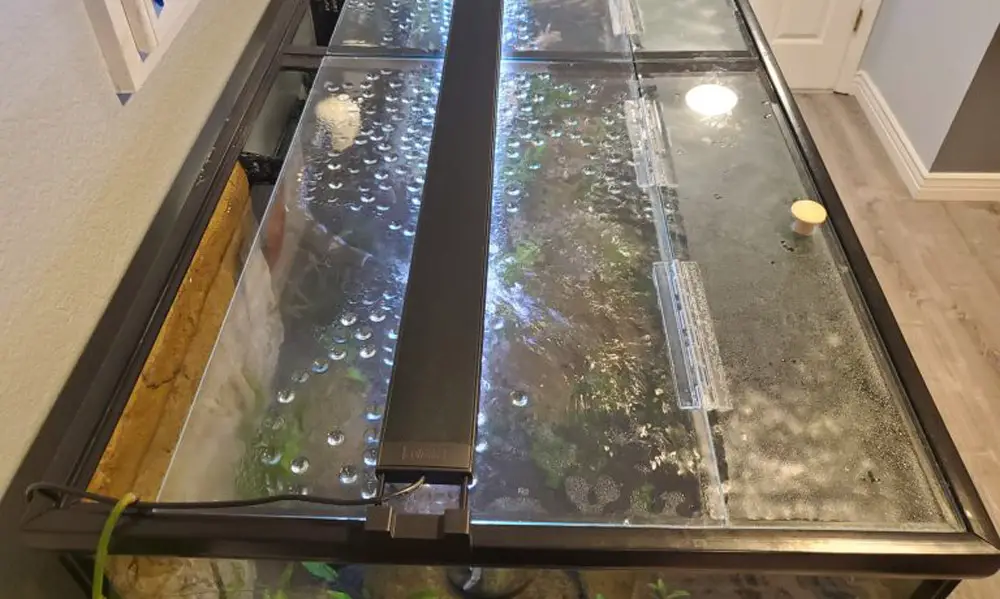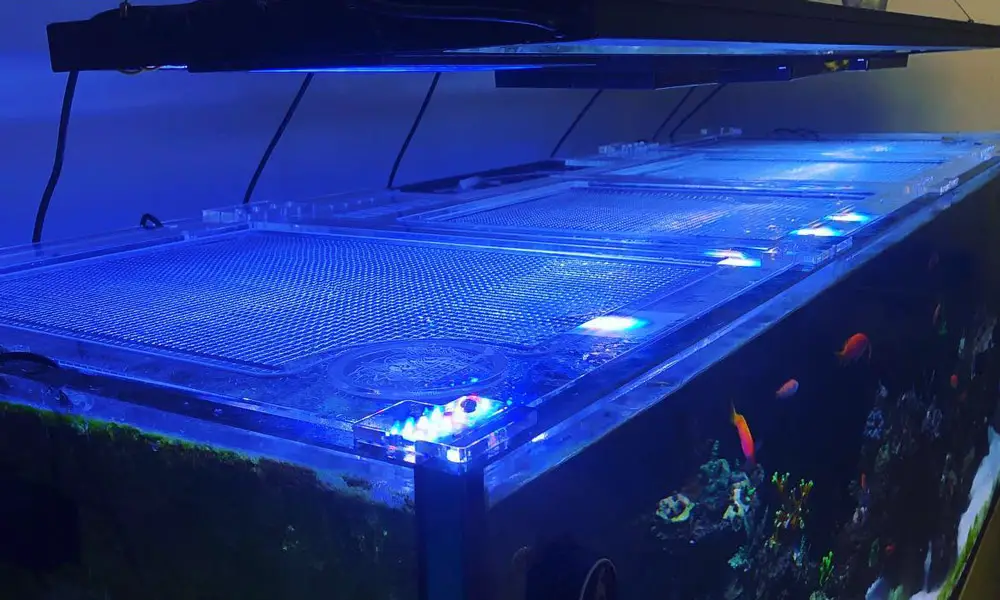An aquarium lid or cover is an essential part of your tank setup, especially if you have many good jumpers. It also serves several other purposes – it prevents debris from falling into the aquarium, keeps out your curious cat or other pets, and provides a tight seal to reduce evaporation that contributes to humidity in your home.
You can buy a commercial aquarium lid or cover from your local pet store, but they can be expensive, so why not make your own?
With a few household supplies, you can easily build a custom aquarium lid that fits your tank perfectly. It’s cheaper and works better; more importantly, it’s FUN!
This guide is not a step-by-step tutorial but 10 easy and cheap DIY fish tank lid ideas to get you inspired.
Glass Aquarium Lids
Glass aquarium lids are a clear choice (pun intended) when it comes to durability, effectiveness, and versatility.
The Pros
Let’s first look at a list of advantages of using a glass aquarium lid:
- It provides an excellent seal to prevent evaporation and maintain moisture.
- It won’t develop cloudy or foggy appearances over time.
- It’s more durable and won’t bend or sag like acrylic lids.
- It’s made custom for your aquariums so that you can choose predefined dimensions.
- It’s easy to clean.
The Cons
There are some disadvantages and limitations that are challenged by solid glass lids:
- It works better on aquariums with a rim at the top.
- It’s breakable, and you and your fish can get injured.
- It tends to be a bit more expensive.
In my humble opinion, the long-term benefits definitely outweigh the potential risks. I’ve used these lids for years in my different aquariums, and only one was broken because of an overly excited dog that leaped onto the coffee table. I also have never heard of anyone getting seriously hurt by a glass aquarium lid. If you’re always careful, it shouldn’t be an issue.
Don’t be intimidated by the glass-cutting process; it’s not as difficult as you think. These DIY glass lids are simple enough for anyone to accomplish.
DIY Sliding Glass Aquarium Lids
This fantastic yet simple design works better for small aquariums. It provides an excellent seal while still allowing easy access to the aquarium. All you need is a sheet of tempered glass, some outside corner moulding, and a handle. You can find all of these supplies at your local hardware store.
Painting these corner mouldings might have looked better to match the trim for “show” tanks. Tempered glass is also more expensive than regular glass, but it’s worth the investment for safety.
You would be interested to know: Where to Buy & Cut Glass for DIY Aquariums
How to Make Sliding Glass Aquarium Lids
This instructional video from Steve Poland Aquatics seems to be the originator of the sliding design. Steve does a great job of explaining how to make these lids step-by-step. If you decide to cut the glass by yourself, be careful as you can easily cut yourself.
If you’re going to use tempered glass, you’ll need to order it a few days in advance. In addition, it’s a smart option to ask the seller to polish and sand the edges to prevent an injury. For the handle, a pack of adhesive wall hooks works great and is readily available at any dollar store.
DIY Hinged Glass Aquarium Lids

Most commercial glass lids come with two thicker, tempered glass panels hinged together. This design is very popular because it’s easy to open and reliable for larger aquariums.
These commercial lids feature a dark plastic hinge around the whole lid. As a result, it creates a noticeable shading in your aquarium. Instead, this design uses four clear acrylic hinges in the middle, so there’s no shading over the aquarium.
This looks better and allows you to open just one-half of the lid, making it easier to feed your fish or work on your aquarium. You can make your own by following this guide from Odin Aquatics.
Plastic (Acrylic & Polycarbonate) Aquarium Lid
Acrylic plexiglass sheets and polycarbonate panels are two types of clear plastic that can also be used for aquarium lids. These synthetic glasses are much cheaper than standard glass but only half the weight of comparably sized glass by volume.
Interestingly, acrylic sheets can withstand roughly 17 times the impact of traditional glass, and polycarbonate is even stronger, with impact resistance 250 times that of traditional glass. Many DIY aquarium lid kits use these materials thanks to their durability and low cost.
Nevertheless, these options do have their own set of pros and cons [1]:
| Acrylic or Plexiglass | Polycarbonate | |
|---|---|---|
| Pros | 1. Easier to cut than polycarbonate 2. Can be polished, both for scratches and clean edges 3. Better glue bonding 4. Clearer 5. Cheaper by as much as 35% | 1. Greater strength than acrylic 2. More flexible than acrylic; can be shaped at room temperature 3. Can be exposed to high temperatures and is non-flammable 4. Highly resistant to chemicals 5. Can be drilled without cracking 6. Lighter in weight than comparable acrylic |
| Cons | 1. More rigid 2. More likely to crack during drilling or upon impact 3. More likely to chip 4. Should not be exposed to open flames | 1. Scratches easily 2. Cannot be polished 3. Can be dented easily 4. More translucent than transparent as compared to acrylic |
As an insatiable DIYer, below are several designs and methods I’ve used in the past to create my own aquarium lids.
DIY Polycarbonate Aquarium Lids
When people think of polycarbonate panels, they often think of conservatories and greenhouses since this thermoplastic material is virtually unbreakable and is capable of transmitting light within the 80 to 90 percent range [2].
For our purposes, we can use it to create a practically indestructible aquarium lid that will provide many years of service. It will not bend or warp like acrylic sheets and won’t crack or shatter like glass.
This video will show you how to make your polycarbonate aquarium lid. Because of the superior strength of polycarbonate, you will need to use a table saw to cut it down to the dimensions you require. If you don’t have access to a table saw, you can have your local hardware store or glass company make the cuts for you.
DIY Acrylic Rimless Aquarium Lid
Acrylic or Plexiglass Sheeting is cheaper, looks clearer, and is easier to work with. However, some issues you may face sooner or later:
- Acrylic will slowly start to bend if not stiffened.
- The condensation that builds up inside will drip from the edges onto the table.
- Acrylic tends to become yellowish.
Personally, I always recommend using polycarbonate instead of acrylic to avoid these issues. The extra money definitely is worth the investment, in my opinion.
If you decide to use acrylic anyway, this video tutorial shows you how to make a basic rimless aquarium lid out of plexiglass. You’ll need some tools to make the cuts, but it’s still a relatively easy project that most people can do. You’ll need to ensure the measurements are precise so that the lid fits snugly on your tank.
DIY Bow Front Lids
If you have a front bow tank, you know how it can be difficult to find a ready-made lid that fits perfectly. Even if you do find one, it’s often expensive. The good news is that you can make your own for a fraction of the cost.
This video will show you how to make a custom aquarium lid for a bow front tank. I like the idea of using a piece of the hinge to connect the glass and plexiglass panels together. This way, you can open one side of the lid at a time, making it easier to feed your fish or work on your aquarium. More importantly, it looks much nicer than a piece of rectangular lid.
Looking for how to cut the perfect shape out of plexiglass? Check out this video:
DIY Aquarium Hood With Lights – The king of DIY
Adding lights to your aquarium hood is a great way to show off your fish. In this video, Joey shows you how to build the aquarium cover lids with the led lighting for a 375 gallons aquarium.
Given the fact whether you use a glass or plexiglass lid, the light will be blocked to some extent. In order to ensure that your fish have enough light, you may be interested in the next two ideas.
How To Build a Mesh/Screen Aquarium Lid
Clear netting lets more light (up to 99% ) in than glass or plexiglass, making it a good choice for reef tanks. Also, it allows proper evaporation and builds up salt creep that can occur with glass or Acrylic lids.
In this video, you’ll learn everything you need to know about making a stylish mesh screen top using clear netting and some basic framing materials. You’ll also see how to add a frame to the lid to make it more sturdy. It works for both rim and rimless aquariums, but you may need to make some adjustments for the latter.
DIY Egg Crate Aquarium Lid
Another great idea for an aquarium lid is to use egg crates. The egg crate is a material often used for numerous things, including skimmer stands, frag racks, and of course, lids.
What’s great about the egg crate is that it has very little impact on light penetration. You can assemble it in any shape or size that you need.
It’s 100% reef safe and can be used in both freshwater and saltwater aquariums. For saltwater aquariums, it’s best to use a black egg crate since it’s less likely to attract plague algae growth.
In this video, you’ll learn how to make a simple egg crate lid for your aquarium. The process is very straightforward and requires a few basic supplies that you probably already have around the house.
Conclusion
Aquarium lids are important, albeit often overlooked, part of any fish tank. They not only prevent fish from jumping out but also help maintain optimal water temperature and prevent evaporation.
If you’re looking for a cheap and easy option, acrylic lids are probably your best bet. For those who want something that looks a little nicer and lets more light in, then egg crate or mesh screen lids are good choices.
We hope these 10 diy aquarium lid ideas have inspired you to make your own! Which one is your favorite? Do you have any other tips or tricks for making diy aquarium lids? Share your thoughts in the comments below! Don’t forget share your photos and videos with us once you’re done.
Article Sources:
- What is the Difference Between Polycarbonate and Acrylic? [Link]
- Why more growers are choosing polycarbonate panels [Link]
